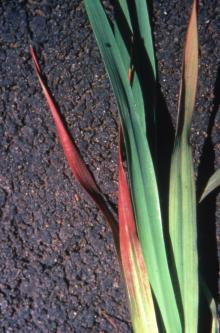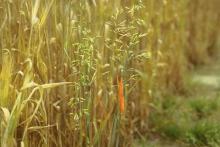See:
Barley (Hordeum vulgare) - Barley Yellow Dwarf
Grass for Seed - Barley Yellow Dwarf
Cause Barley yellow dwarf virus (BYDV) infects many cereals and grasses. Many grassy species in non-managed grasslands present in the Pacific Northwest are susceptible to BYDV, including: Achnatherum lettermanii, A. occidentale, A. thurberianum, Alopecurus pratensis, Bromus inermis, Danthonia intermedia, Elymus elymoides, Poa bulbosa, P. fendleriana, P. secunda, Sporobolus airoides, and S. cryptandrus. It is a problem worldwide on barley, oats, and wheat. Some hosts may not show visible symptoms of infection. BYDV is transmitted by several species of aphid, including the bird cherry-oat aphid (Rhopalosiphum padi), green bug aphid (Schizaphis graminum), corn leaf aphid (Rhopalosiphum maidis), and English grain aphid (Sitobion avenae). Virus strains transmitted primarily by Rhopalosiphum padi are now called Cereal yellow dwarf virus-RPV (CYDV-RPV), those transmitted by Sitobion avenae (formerly Macrosiphon avenae) are called MAV, and those transmitted by both aphid species are called PAV. Green bug aphid is not adapted to climatic conditions west of the Cascade Range.
Disease is more severe in cool, moist weather. In the Willamette Valley, Oregon, cool, moist conditions in spring or fall favor epidemics. Symptoms develop 2 to 4 weeks after infection when temperature is 68°F to 77°F and there is ample light. Damage is not always severe, it is influenced by the growth stage at infection; more severe symptoms occur when plants are infected as seedlings.
Symptoms Symptoms can be variable and may be confused with nutrient deficiencies or stress; presence of BYDV (or CYDV-RPV) needs to be confirmed by serological tests. A common symptom is reddish leaf tips.
Cultural control
- Plant in late fall or early spring so the susceptible seedling stage is before or after peak flights of the insect vectors during warm summer months.
- In affected plantings, reducing stress on plants by maintaining balanced fertility and adequate soil moisture can aid in minimizing losses.
Chemical control Apply granular systemic insecticides in-furrow at planting to reduce aphid numbers. (For materials, rates, and procedures, consult the PNW Insect Management Handbook.)
Reference Ingwell, L.L. and N.A. Bosque-Perez, N.A. 2015. New experimental hosts of Barley yellow dwarf virus among wild grasses, with implications for grassland habitats. Plant Pathology 64:1300-1307.



